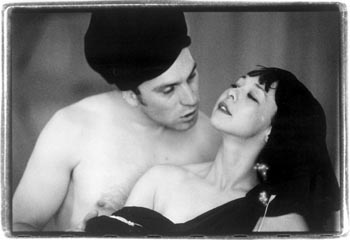![[MetroActive Stage]](http://metroactive.com/stage/gifs/stage468.gif)
![[MetroActive Stage]](http://metroactive.com/stage/gifs/stage468.gif)
[ Stage Index | SF Metropolitan | MetroActive Central | Archives ]
Dream My State of Affairs
Steamy Stuff: Performers Don Decker and Jane Schnorrenberg are haunted by their obsessive dreams in Della Davidson's Night Stories.'
In an adaptation of Chilean author Isabel Allende's The Stories of Eva Luna, choreographer Della Davidson reveals dreams and magic realism
By Giancarlo Davis
Dreams are the raw material for many of the productions by local choreographer Della Davidson. The protagonists in her performances are haunted by dreams: obsessive dreams that shape their lives and, according to Davidson, are easily revealed through movement.
Her current production, a dance epic titled Night Stories: The Eva Luna Project First Cycle, is an ambitious adaptation of several of Isabel Allende's Eva Luna stories. Its Flamenco singing and spoken lines give a theatrical and operatic air to the production. Live music is supplied by the Clubfoot Ensemble (a reduced version of the Clubfoot Orchestra), whose beguiling adaptations of Nino Rota compel many to take a dreamy Fellini-esque wade through their own imaginations.
A previous Davidson effort rendered the lurid confessional "Transformations" by Anne Sexton as the nightmarish The 10 p.m. Dream, a mythical escapade resembling an errant turn down a dark alley while in a dreamy state. "All of my previous works have led up to and have each in their own way contributed to Night Stories," says Davidson about her fledgling work-in-progress.
Three stories form the basis for this first Eva Luna cycle. "Wicked Girl" involves a "scrawny whelp" of an adolescent who is discovering her sexual identity and has "the dull skin of solitary children and a mouth revealing gaps still unfilled by second teeth." "Tosca" tells of a woman shaping her reality to fit the fantastic lifestyles of her favorite opera heroines, and "Revenge" concerns a young girl who avenges the death of her father, killed by a violent insurgent.
"The Eva Luna stories all focus on love, loss and desire in one way or another," Davidson continues. "Allende's narrative style is exceptionally lush and sensual. Love, the real force behind these stories, carries the characters right into the dance medium. For example, the emotionally complex story 'Tosca' has a scene in which a girl denies her prodigal talents as a musician and, despite her voice (Allende describes it as 'a small, birdlike voice barely strong enough to lull an infant from its cradle'), opts for a failing career in singing. I use an image in the initial part of the story, in which the girl, after declaring her intention to pursue her ill-fated career, leaves an audience-filled room in order to play with her doll. The dance I have developed from this sequence is a scene in which the little girl immerses herself in playing with her dolls (portrayed by dancers), which I believe to be representative of the girl's illusion."
Davidson's complex dances also seek to integrate Allende's magic-realism sensibilities and the characters' powerful femininity that overshadows the rest of their milieu. "Magic realism flourishes for the most part from the intense spirituality of the Spanish culture," explains Davidson. "Unlike English, which to me is a language of commerce, Spanish itself is deeply spiritual and therefore intensely lyrical. Flamenco singing adds the spiritual texture to the dances and heightens the stories' magic realism."
And what of future Davidson works? Who knows, with Davidson's unique talents for adaptation, Borges and Garcia Marquez may one day also be transformed into dance. But right now it's all a dream.
Copyright © Metro Publishing Inc. Maintained by Boulevards New Media.

Fred Hayes
At Theater Artaud, 450 Florida Street, Sept. 26-28; 8pm with 2pm matinees on Sat. and Sun.; $12.50-$18.50; 415/621-7797.
From the September 1997 issue of the Metropolitan.